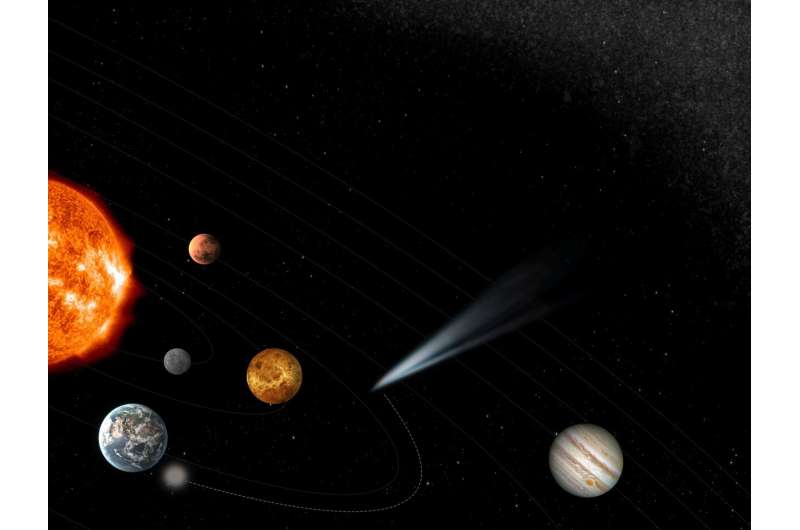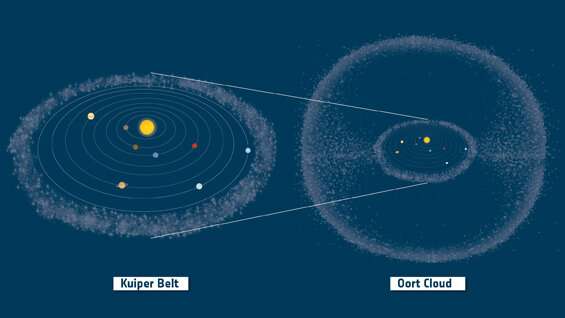ESA's new mission to intercept a comet

"Comet Interceptor" has been selected as ESA's new fast-class mission in its Cosmic Vision Programme. Comprising three spacecraft, it will be the first to visit a truly pristine comet or other interstellar object that is only just starting its journey into the inner Solar System.
The mission will travel to an as-yet undiscovered comet, making a flyby of the chosen target when it is on the approach to Earth's orbit. Its three spacecraft will perform simultaneous observations from multiple points around the comet, creating a 3-D profile of a "dynamically new" object that contains unprocessed material surviving from the dawn of the Solar System.
"Pristine or dynamically new comets are entirely uncharted and make compelling targets for close-range spacecraft exploration to better understand the diversity and evolution of comets," says Günther Hasinger, ESA's Director of Science.
"The huge scientific achievements of Giotto and Rosetta—our legacy missions to comets—are unrivaled, but now it is time to build upon their successes and visit a pristine comet, or be ready for the next "Oumuamua-like interstellar object."
What is a fast mission?
Comet Interceptor is a "fast," or F-class mission. "Fast" refers to the implementation time, with a total development duration from selection to launch readiness of about eight years. F-class missions, which have a launch mass of less than 1000 kg, will share the ride into space with a medium-class mission, taking advantage of additional space in the launcher and the boost to the sun-Earth Lagrange point L2, which is 1.5 million kilometres "behind" Earth as viewed from the sun.
Comet Interceptor is foreseen for launch as co-passenger with ESA's exoplanet-studying ARIEL spacecraft in 2028. Both missions will be delivered to L2 and from there Comet Interceptor will journey onwards to the chosen target using its own propulsion system.
The selection process has also been fast. Following a call for missions in July 2018, 23 pitches were submitted by the space science community, with six teams subsequently invited to provide more detailed proposals. Among them, Comet Interceptor was chosen at today's Science Programme Committee to move into a more detailed definition phase.
"We thank the space science community for their excellent proposals, which covered a broad range of novel topics that could be explored within the constraints of the F-class guidelines," says Director Hasinger.
"This type of innovative mission will play an important role in supplementing ESA's Science Programme as we plan for the next decades of scientific exploration of our Universe.

"We are also happy to maintain the fast mission philosophy by selecting Comet Interceptor within a year since the original call for proposals was made."
What's new about comet interceptor?
Comet Interceptor comprises three spacecraft. The composite spacecraft will wait at L2 for a suitable target, then travel together before the three modules separate a few weeks prior to intercepting the comet. Each module will be equipped with a complementary science payload, providing different perspectives of the comet's nucleus and its gas, dust, and plasma environment. Such multi-point measurements will greatly improve the 3-D information needed to understand the dynamic nature of a pristine comet while it is interacting with the constantly changing solar wind environment.
The mission's instrument suite will draw on heritage from other missions, including a camera based on the one currently flying on the ExoMars Trace Gas Orbiter, along with dust, fields and plasma instruments, as well as a mass spectrometer, like those that flew on ESA's Rosetta.
Previous comet missions, including ESA's pioneering spacecraft Giotto and Rosetta, encountered short-period comets. These are comets with orbital periods of less than 200 years that have approached the sun many times along their orbits in relatively recent times and as a consequence have undergone significant changes: Rosetta's comet, 67P/Churyumov-Gerasimenko orbits the sun once every 6.5 years while Comet 1P/Halley, visited by Giotto and other spacecraft in 1986, returns to our skies every 76 years.
Comet Interceptor is different because it will target a comet visiting the inner Solar System for the first time—perhaps from the vast Oort cloud that is thought to surround the outer reaches of the sun's realm. As such, the comet will contain material that has not undergone much processing since the dawn of the sun and planets. The mission will therefore offer a new insight into the evolution of comets as they migrate inwards from the periphery of the Solar System.
Although much rarer, another example of a potential target is an interstellar interloper from another star system, like the famed "Oumuamua that flew past our sun on a highly inclined orbit in 2017. Studying an interstellar object would offer the chance to explore how comet-like bodies form and evolve in other star systems.
In the past, new comets have only been discovered a few months to years before they pass through their closest approach to the sun, which is too short notice to plan, build and launch a space mission, and for it to travel to the specific object before it moves away from the sun again.
Recent advances in ground-based surveys mean that the sky can be scanned more deeply and longer notice can be provided. Pan-STARRS is currently the most prolific comet discovery machine, with more than half of all new comets per year uncovered by the survey. The Large Synoptic Survey Telescope, currently under construction in Chile, will also greatly increase the catalog of new comets.
In any case, the destination for Comet Interceptor does not need to be known while the mission is being prepared; the spacecraft can be ready and waiting in space for a suitable comet encounter, and is expected to complete its mission within five years of launch.
Provided by European Space Agency





















